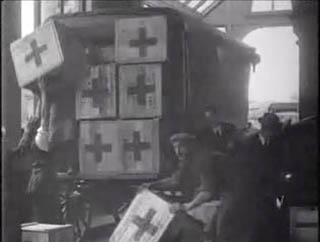Description
This is an excerpt from a 1917 segment of the 'Australian Gazette', a black-and-white silent newsreel showing Australian Red Cross supplies being dispatched from Federal Government House in Melbourne to be sent to Australian soldiers in the First World War. The excerpt begins with the title: 'THE AUSTRALIAN GAZETTE Published Weekly BY AUSTRALASIAN FILMS AUSTRALIA No. 312'. The opening intertitle states: 'MELBOURNE First shipment of Red Cross supplies for Egypt leaving FEDERAL Government House'. The excerpt then shows men, probably volunteers, rolling tea chests marked with the Red Cross emblem down some stairs to what appears to be a porch. The chests are then loaded onto motorised and horse-drawn vehicles, which are driven away.
Educational value
- This asset features the Australian Red Cross Society (ARCS) - the ARCS was formed in Melbourne on 3 August 1914, just after the outbreak of the First World War (1914-18), initially as a branch of the British Red Cross Society; its first president was Lady Helen Munro-Ferguson (1865-1941), wife of the then Governor-General of Australia, Sir Ronald Munro-Ferguson (1860-1934); from Federation in 1901 until the establishment of Canberra in 1927, Governors-General were based in Melbourne, and resided at Federal Government House.
- It highlights part of the work of the ARCS during the War - using the ballroom of Federal Government House in Melbourne as headquarters, the ARCS dispatched more than 400,000 'comfort parcels' of food and clothing to Australian prisoners of war and to hospitals that were treating Australian soldiers.
- It shows men who were probably performing voluntary work for the ARCS - the ARCS relied on volunteers, and thousands of people across Australia, most of them women, gave up time and money to support its activities during the War, viewing their labour as part of the 'war effort'.
- It is a reminder of the connections between Australia and Egypt in the War - the first group of the 300,000 Australian men who enlisted to fight in the War were sent to Egypt for training before being sent to Gallipoli in Turkey, where they arrived on 25 April 1915; throughout the War, Australians spent time in Egypt for training or recovery from injuries as Allied forces fought in various parts of the Middle East.
- It shows Red Cross supplies being sent to Egypt in 1917, the year after the operations of the ARCS in Egypt were severely criticised by a senior Australian medical officer stationed there - a subsequent inquiry found that distribution of 'comfort parcels' in Egypt could have been better managed; however, the official history of Australia in the War described the work of the ARCS in Egypt as 'a valuable - in some respects even necessary - adjunct to the work of the medical service'.
- It is an excerpt from silent film footage produced by Australasian Films - created in 1913 as the production arm of Union Theatres, Australasian Films ceased production in about 1928, unable to compete with the new overseas-made films that featured sound; Union Theatres is now part of the Greater Union Organisation, Australia's oldest film exhibitor.
- It is an example of film footage in which the action appears to take place relatively fast - this is because silent films were shot at slower speeds or 'frame rates' (about 16 to 23 frames per second) than later films that included sound (which were typically shot at 24 frames per second); for the action to appear to take place at a normal speed in silent films, they have to be played at the same speed at which they were shot.
- It is an example of a segment from the weekly black-and-white silent newsreel program the 'Australian Gazette', which had intertitles (information or comments for the viewers to read) - newsreels, which covered local and overseas current events, were shown in movie theatres from the early 1900s to the 1970s; versions of the newsreels produced by the French company Pathe and its British offshoot were shown in Australia before Australasian Films began producing editions of the 'Australian Gazette', later called the 'Australasian Gazette'; these in turn were replaced by 'Cinesound Movietone' newsreels.

